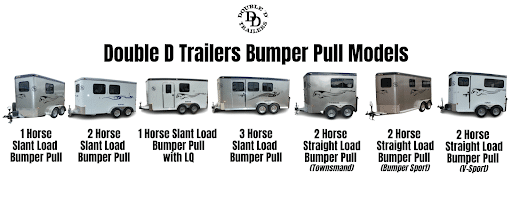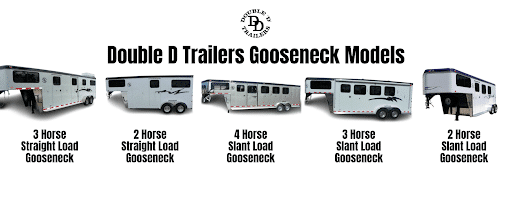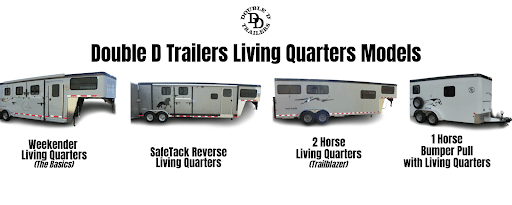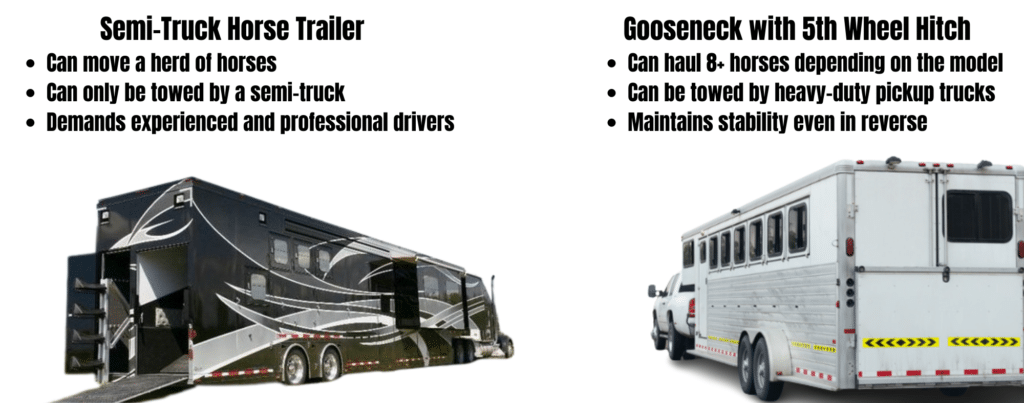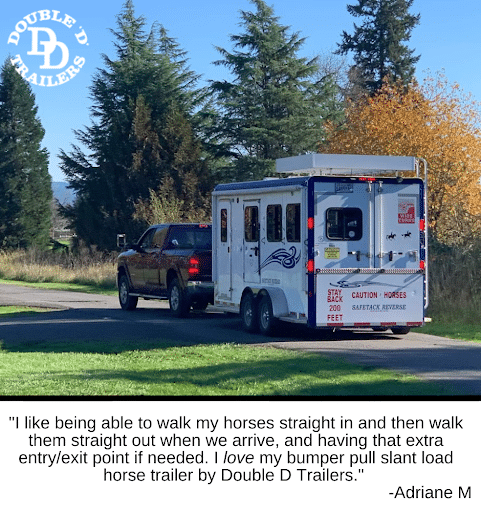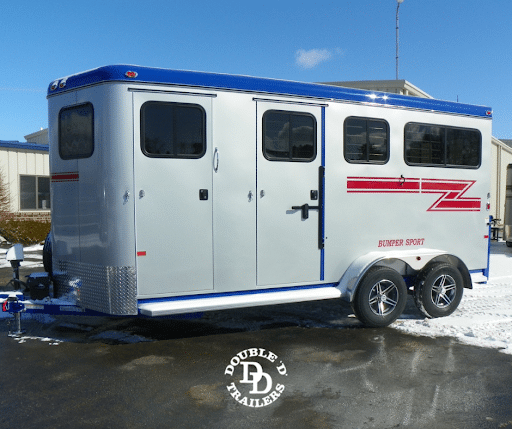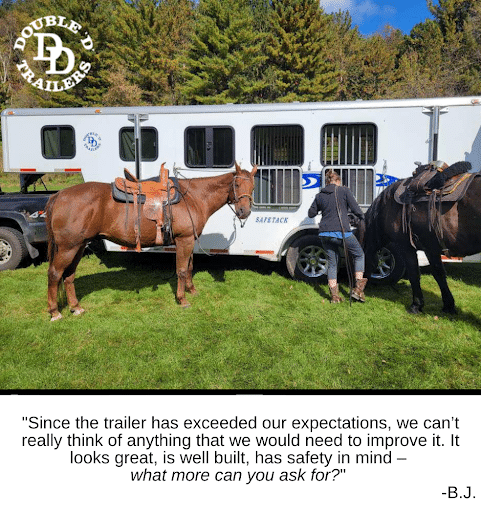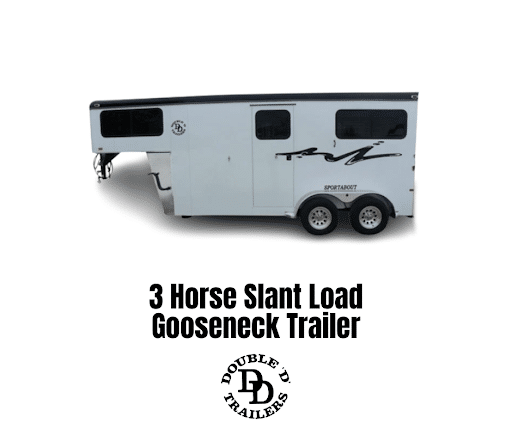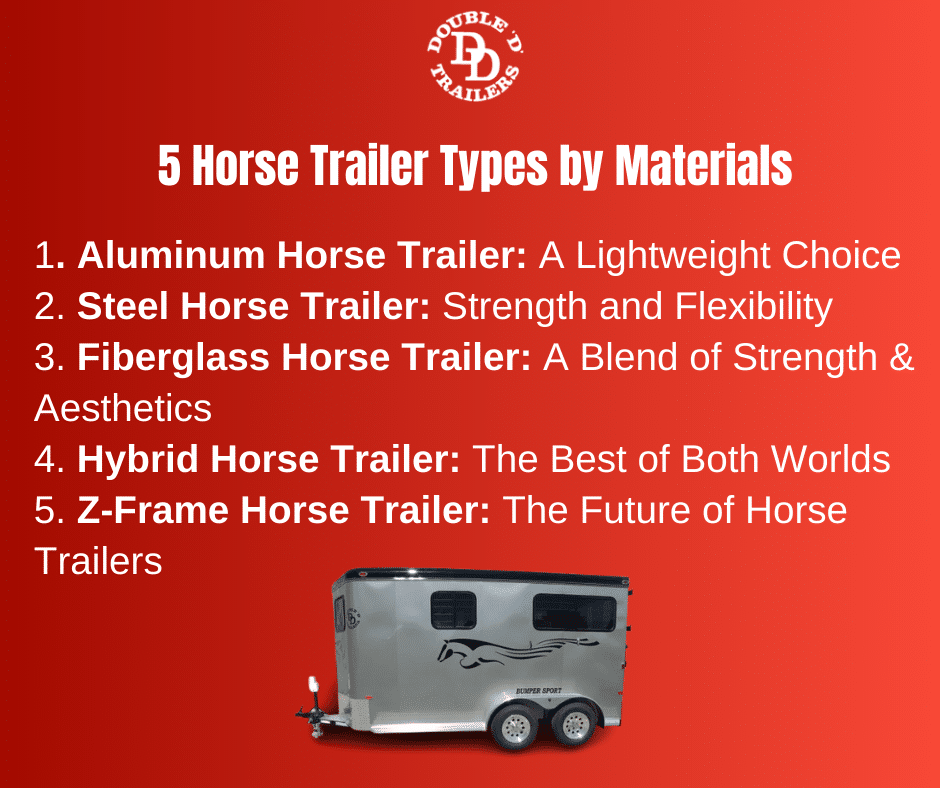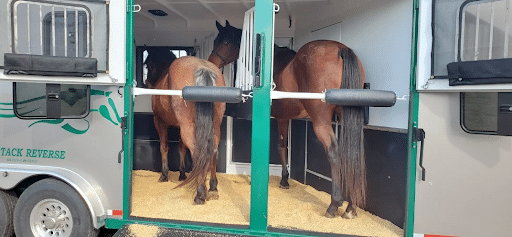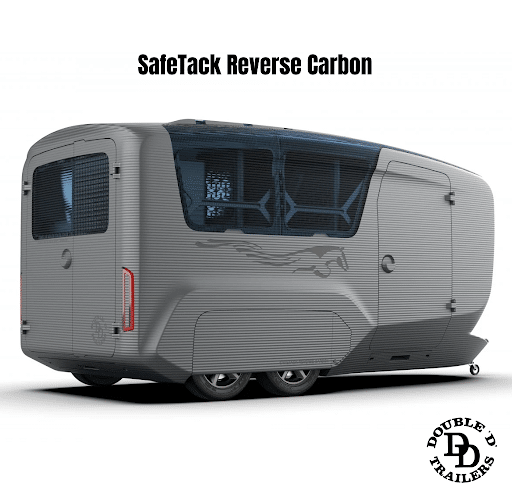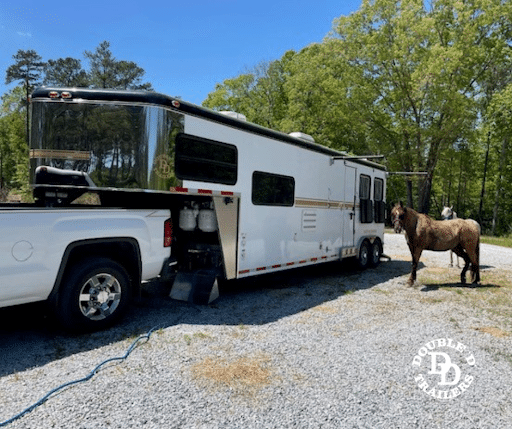23 Horse Trailer Types to Know: Which One Should I Buy?
Ever found yourself scratching your head, wondering which horse trailer is the perfect fit for you and your four-legged friend? With a sea of choices out there, it's essential to get it right. And here's why: A recent 2022 study by Riley, Rogers, et al. showed a staggering 71% of horse injuries in New Zealand had ties to road transportation. Comparable studies conducted independently in Italy, Australia, and right here in the US reported similar statistics. Now, while these studies don't directly point fingers at specific trailer types, they sure do underline the importance of picking the right one.
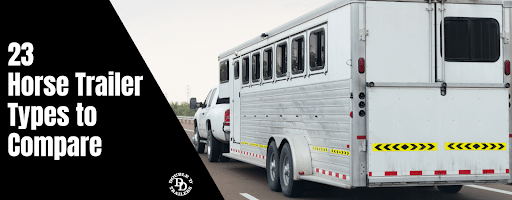
Ready to unravel the mystery of the 23 horse trailer types? Dive in because this guide will empower you to find that perfect trailer – one that promises safety, value for money, and a comfy ride for both you and your horse.
How Do I Choose the Best Horse Trailer Type?
Setting your priorities in order when buying a horse trailer is the most important step. The key isn't about snagging the biggest or splurging on the priciest. It's all about zeroing in on what fits your unique needs. Picture this: If you're the proud owner of a quartet of horses and love the idea of a home-away-from-home on wheels, then a 4-horse gooseneck trailer with cozy living quarters might just be your dream come true.
To streamline your decision-making process, ask yourself these seven questions:
- How many horses will you be transporting?
- How much tack and other gear will you need to load?
- What’s the capacity of your current tow vehicle?
- What breed are your horses?
- Are your horses seasoned travelers or first-time trailer riders?
- Do your equestrian adventures span more than a weekend?
- Is it all about the big-name brands for you, or are you open to a hidden gem from a lesser-known manufacturer?
Your answers to these questions are the blueprint for your trailer shopping list. But remember, it's all about syncing up with what you truly need. So now, it’s time to set your eyes on the type of horse trailer you need.
Generally, you'll find horse trailers sorted by hitch types: bumper pull, gooseneck, 5th wheel, and semi-truck variants. Some enthusiasts prefer to narrow down their horse trailer choices by loading configurations: straight load, slant load, center load, side load, and reverse load. For others, materials matter the most, and the choices can range from robust alloy steel and lightweight aluminum to innovative composites or hybrid combinations. Additionally, you might want a trailer that can accommodate varying horse numbers and come equipped with amenities like living spaces, tack storage, and more. We're here to guide you through each type, highlighting its purpose, perks, potential pitfalls, safety pointers, and typical sizes.
If none of these conventional options hit the mark, a custom-crafted horse trailer might be your answer. As long as you’re clear on your prerequisites, you're all set to embark on your horse trailer journey, starting with the ins and outs of hitch types.
Horse Trailers by Towing or Hitch Types
When it comes to horse trailers, the hitch type plays a pivotal role. Why? Because each trailer is crafted with a specific purpose in mind. Factors like size, load capacity, and other nuances mean that certain trailers demand hitch mechanisms robust enough to handle increased tongue weight.
The four primary hitch configurations for horse trailers are bumper pull, gooseneck, 5th wheel, and semi-truck trailers.
1. Bumper Pull Horse Trailer
Bumper pull horse trailers, often referred to as tag-alongs (which is the correct spelling as opposed to “tagalong” or “tag along”), are the go-to for many equestrians. Your standard SUV or truck, equipped with the right hitch, can easily tow them, as long as either has a proper hitch coupling. They might be the lightest contenders in the trailer world, but don't be fooled. Some models pack a surprising amount of space within their compact frame.
They are almost always smaller than goosenecks and more affordable. In fact, the 2-horse bumper pull configuration is a global favorite. Tag-along trailers are a breeze to tow and navigate, although mastering their maneuverability does come with a learning curve.
What are Bumper Pull Horse Trailers best used for?
- Traveling on short-distance trips
- Hauling 1 or 2 horses
- Towing by RVs or SUVs
- Navigating tricky, narrow roads
What are the advantages of Bumper Pull Horse Trailers?
- Lighter than other trailer types (such as goosenecks, for example)
- Easier to tow on narrow roads
- Budget-friendlier than goosenecks
- Simpler to maintain than their larger counterparts
What are the drawbacks of Bumper Pull Horse Trailers?
- Lesser interior space
- Harder to fit larger horse breeds due to smaller horse stalls
What safety concerns should I consider when buying a Bumper Pull Horse Trailer?
- Weak side walls and roof structure
- Slippery floor and ramp
- Lack of an escape door
- Compromised stability when towing
- Potentially problematic horse divider design
What are the standard sizes and dimensions of Bumper Pull Horse Trailers?
- Average height: 7’2″ to 7’6″
- Average interior width: 6'7”
- Average exterior length: 15’
- Average weight: 2,200 to 4,100+ pounds (a standard bumper pull horse trailer with living quarters weighs about 4,000 pounds, for example)
>> CUSTOMERS FREQUENTLY BOUGHT THE SAFETACK 2 HORSE BUMPER PULL HORSE TRAILERS
2. Gooseneck Horse Trailer
The gooseneck horse trailer features a distinct design (hence the name) that comprises a prominent main trailer body with a smaller overhang that attaches to a truck's bed. This horse trailer type seamlessly combines space, stability, and style - often boasting living quarters and stabling for at least 2 horses.
To hitch up a gooseneck, you'll need a coupling nestled in a truck's bed. And speaking of trucks, you'll want a larger pickup for this task; smaller vehicles just won't cut it.
One of the standout features of goosenecks is their stability on the road. Inside, they offer a spacious haven, often partitioned into horse stalls, a tack room, living quarters, and extra storage. While they pack in many features, they also come with a heftier price tag than bumper pulls.
What are Gooseneck Horse Trailers best used for?
- Transporting 2, 3, or more horses on longer distances (up to 8 horses, although you can opt for a cozy 1-horse configuration)
- Carrying heavier loads than your typical tag-along
- Offering a comfortable stay during equestrian events
- Accommodating larger horse breeds
What are the advantages of Gooseneck Horse Trailers?
- Roomier interior suitable for tack rooms, storage, and living quarters
- Easier maneuverability
- Better load capacity
- Fewer tongue weight issues (the hitch mechanism is on top of the truck’s rear axle)
- More susceptible to customization
- More stable handling during towing compared to bumper pull trailers
What are the drawbacks of Gooseneck Horse Trailers?
- Trickier to maneuver and pull due to bigger size and weight
- Steeper price than tag-along trailers
- Harder to maintain
What safety concerns should I consider when buying a Gooseneck Horse Trailer?
- Excessive wear and poor maintenance (when buying a used gooseneck bumper pull horse trailer)
- More braking power required due to the bigger weight
What are the standard sizes and dimensions of Gooseneck Horse Trailers?
- Average height: 7'6" to 7'8"
- Average stall width: 40"
- Average exterior length: up to 45’
- Average weight: 4,000 to 6,500 pounds
>> OUR GOOSENECK BESTSELLER: 3 HORSE GOOSENECK SLANT LOAD TRAILER
3. Horse Trailer with Living Quarters
Horse trailers with living quarters (LQ) come in all hitch types and sizes – bumper pull, gooseneck, 5th wheel, and semi-truck variants, and from 1 to 4-horse layouts, sometimes even more. LQ horse trailers blend functionality and comfort for both you and your horse by providing a cozy accommodation onboard in a separate section from the horse area. Among the myriad of options, the 2-horse weekender living quarters gooseneck trailer stands out, thanks to its perfect balance of size and features.
What are the common interior features of a horse trailer with living quarters?
Common living quarters horse trailer features are the following:
- Dinette
- Kitchen
- Toilet
- Shower
- Sleeping area
- Storage area
- Wall cabinets and organizers
- Flush lighting
- Soft walls
- Hardwood floors
What are horse trailers with living quarters best used for?
- Spending a few nights during equestrian events instead of paying for hotel bills
- Ensuring a safe and comfortable journey for both riders and horses
What are the advantages of horse trailers with living quarters?
- More economical in the long run by dodging hotel and dining costs
- More comfortable and safe to take a quick nap or a good night’s sleep than any tent
- More practical storage solutions for all your gear
- More comfortable and climate-controlled premises than any standard trailer
- More options for utilities like water tanks or solar panels, depending on the model
- Better organized interior space that doesn't skimp on horse space
What are the drawbacks of horse trailers with living quarters?
- Heftier price tag compared to their no-frills counterparts
- Weightier because of additional amenities and features
What safety concerns should I consider when buying a horse trailer with living quarters?
- All interior features should have no sharp edges, and all the equipment should be mounted securely
- Possible issues such as rust, leaks, or mold when buying a second-hand LQ trailer
>> FIND THE LIVING QUARTERS HORSE TRAILER OF YOUR DREAMS
4. 5th Wheel Horse Trailer
A 5th wheel horse trailer is simply a gooseneck trailer, but with a special twist: it uses a 5th wheel hitch, also known as a kingpin coupler. The name "5th wheel" comes from this unique hitch design. Instead of the typical ball hitch you'd find on goosenecks, 5th wheel trailers have a jaw hitch and a circular plate. The kingpin snugly fits into this 5th wheel, ensuring a secure connection.
What are 5th Wheel horse trailers best used for?
- Embarking on extended journeys with multiple horses
- Catering to commercial equestrian needs
- Traveling on all longer highway and interstate routes
- Enjoying top-notch accommodation for those long hauls
- Transporting large professional equestrian teams
What are the advantages of 5th Wheel trailers?
- Smoother ride and maximum comfort for horses and humans
- More stable on the road than gooseneck and bumper pull trailers
- Better load capacity ensures comfort, even with multiple horses onboard
- Easier maneuverability: thanks to unique hitch design, backing up is simpler
What are the drawbacks of 5th Wheels?
- Longer structure and sometimes way heavier than other trailers
- More specific tow vehicles are required: a 1-ton truck or a semi-truck is needed
- More expensive to buy and maintain
- More difficult to use legally because some models require additional licenses and permits
What safety concerns should I consider when buying a 5th Wheel horse trailer?
- Requires careful turns and braking given their heft
- Necessitates frequent hitch and axle checks
What are the standard size and dimensions of 5th Wheel horse trailers?
- Average interior height: 7'8" to 8'4"
- Average interior depth: 25’ to 36’
- Average exterior length: up to 45’
- Average weight: 15,000 pounds
5. Semi-Truck Horse Trailer
Semi-truck trailers, sometimes referred to as “tractor type horse trailers", connect exclusively to semi-trucks using a 5th-wheel coupling. When you hear "semi-truck trailers" in the equestrian world, you're talking about the big leagues. These behemoths boast unparalleled load capacities. While some models might be compatible with 1-ton pickup trucks, it largely hinges on the trailer's specifications and the truck's load capacity.
Designed to transport a multitude of horses in one go, semi-truck trailers are the epitome of safety and comfort. This category also encompasses the crème de la crème of luxury trailers, tailored for semi-truck towing.
What are semi-truck horse trailers best used for?
- Moving a herd of horses in one trip
- Catering to horse transportation and trailer rental businesses
- Serving professional equestrian endeavors like horse racing teams
What are the advantages of semi-truck horse trailers?
- Spacious stalls and living quarters that outshine other trailers
- Superior loading capabilities, comfortably accommodating 10+ horses
- Abundant storage, especially when pitted against bumper pull trailers
- Safe to tow, given the size
- Plenty customization options
What are the drawbacks of semi-truck horse trailers?
- Heftier price tag and ongoing costs than other trailers
- Harder to tow, demanding larger vehicles, relevant licenses, and permits
- More challenging to maintain and service
- More difficult to tow on narrow roads than all other horse trailer types
What safety concerns should I consider when buying a semi-truck horse trailer?
- Requires extra vigilance when towing and braking
- Tends to sway in windy conditions if not loaded properly
What are the standard sizes and dimensions of semi-truck horse trailers?
- Average exterior width: 8’ to 8'5"
- Average exterior height: 8’ to 11’9”
- Average exterior length: 44’ to 48’
- Average weight: around 15,000 pounds
What are the similarities and differences between a fifth-wheel and a semi-truck or tractor type horse trailer?
5th-wheel horse trailers and semi-truck (tractor-type) both use a 5th-wheel hitch, but the trailers are different in terms of size, capacity, towing prerequisites, maneuverability, and cost.
5th-wheel and semi-truck (tractor-type) horse trailers both use a similar hitching mechanism, but they differ in size, capacity, towing prerequisites, and maneuverability.
Size and Capacity: Semi-truck trailers are significantly larger than 5th wheel trailers, making them the choice for transporting more horses. Those reaching over 50 feet exceed more than triple the size of a standard 2-horse bumper pull trailer. On the other hand, some 5th wheel trailers, despite being smaller, can still house over 8 horses, depending on the model and class.
Towing Vehicle Requirements: Both 5th wheel and semi-truck horse trailers share a hitch type, but while 5th wheels align with heavy-duty pickup trucks, semi-truck trailers demand a semi-truck due to their sheer size and weight. This makes the latter a staple for horse transportation businesses but a tad overkill for private owners.
Maneuverability and Stability: Both 5th wheel and semi-truck horse trailers promise smooth maneuverability and road stability, thanks to their hitch designs - provided they're loaded right. While 5th wheel trailers maintain stability even in reverse, the larger semi-truck trailers demand a seasoned hand, especially on tighter roads.
Ultimately, your choice boils down to your horse count, travel distances, budget, and available towing vehicle.
Horse Trailers by Load Types
Load type is a popular way to filter horse trailers, and the variety of designs in this category allows you to find a perfect solution for your needs. Let's examine the nuances of each type and spotlight what sets them apart.
The 5 types of horse trailers based on loading configuration are slant load, straight load, center load, reverse load and side load.
6. Slant Load Horse Trailer
Slant load horse trailers allow horses to travel in a diagonal position, facing from one wall to another at a certain angle. This ingenious design simplifies the loading and unloading process, allowing horses to exit head first. It's no wonder many equestrians have a soft spot for slant load trailers. Plus, the added bonus? More room for your essential tack, especially in tag-along trailers.
The Double D Trailers slant load horse trailer is a popular choice for stress-free horse transport. With its design allowing straight walk-in and walk-out ease for horses, it’s not just a trailer but a testament to safety and convenience.
What are Slant Load Horse Trailers best used for?
- Transporting up to 4 horses in compact trailers without compromising on safety or comfort
- Providing an affordable means of horse transportation regardless of the route
What are the advantages of Slant Load Horse Trailers?
- Easier and safer loading and unloading
- Roomier stalls due to the increased width
- Better array of customizable options to elevate horse comfort
What are the drawbacks of Slant Load Horse Trailers?
- Demands specific towing vehicles, like 3/4 or 1-ton trucks
- Poses a challenge for larger breeds like Warmbloods (except in custom-built trailers)
What safety concerns should I consider when buying a Slant Load Horse Trailer?
- Not having enough room for your horses in the stall can be a problem
- Poorly designed horse dividers can cause issues
7. Straight Load Horse Trailer
Straight load horse trailers (often referred to as “walk-through”) are classic choices that can house between 1 to 4 horses, all lined up longitudinally. They’re among the most affordable horse trailer types.
The 2-horse bumper pull straight load Double D Trailers is a quiet, rivet-free model.
Every quintessential straight load horse trailer has a rear ramp where horses are loaded from. The stalls are usually spacious enough to let even the larger breeds stretch out.
What are Straight Load Horse Trailers best used for?
- Moving up to 4 horses for short-haul trips or local events
What are the advantages of Straight Load Horse Trailers?
- Pocket-friendly prices compared to their slant load counterparts
- Practical rear loading door and ramp
- Generous stall widths
- Standard emergency exits for added peace of mind
What are the drawbacks of Straight Load Horse Trailers?
- Might lack some safety features found in other horse trailer types
- Limited space for living quarters and additional equestrian gear
What safety concerns should I consider when buying a Straight Load Horse Trailer?
- Reliability of hitch, electrical, and braking systems
- Structural stability of walls, ramp, latches, and roof (for bumper pull trailers)
- Proper design of flooring, ramps, dividers, and butt bars, to name a few
Which is better: a Slant Load or a Straight Load Horse Trailer?
Straight load horse trailers often suit those with larger horses, or for for equestrians who like to keep their horses primarily inside the trailer when not engaged in racing, training, or other activities. Straight load models often cost less than comparable slant load alternatives, too.
Slant load horse trailers, on the other hand, are known to allow for easier loading/unloading compared with straight load alternatives. Plus, if you're someone who carries a lot of tack and gear, this type features ample storage space.
So, how do you choose which is better? It boils down to your unique needs and preferences, such as the following:
- The size, breed, and number of horses you plan to transport
- The volume of tack you typically carry
- The events you frequent and the distances you usually cover
- Your primary purpose: be it shows, racing, training, commercial hauling, or personal transportation
- Your horses' loading habits, size, and preferences
In the end, it's all about finding the perfect trailer type that aligns with your equestrian lifestyle.
8. Center Load Horse Trailer
Center load horse trailers, often referred to as "double-load", "box-stall", or "head-to-head", present a unique configuration wherein horses are positioned in two distinct areas - at the front and back. They face opposite sides while standing in straight stalls, giving this trailer its distinctive name.
One of the standout features of this design is the central loading ramps, which can range from one to three in number. This setup offers the advantage of individually loading and unloading each horse, provided they're comfortable backing up.
What are Center Load Horse Trailers best used for?
- Hauling horses locally or interstate
- Using a relatively compact trailer to transport 4 horses, with individual access to each of them
- Transporting horses for commercial purposes such as pick-up and delivery
What are the advantages of Center Load Horse Trailers?
- Enhanced access to each horse
- Multiple loading ramp options, often featuring 2 or 3 side ramps
- Wider-than-average stalls in some models
- Optimal stall positioning (can soothe anxious horses when they face each other)
What are the drawbacks of Center Load Horse Trailers?
- Less room for equipment and no designated areas for tack
- Fewer options to separate horses, which might lead to potential conflicts
- Simpler dividers and butt bars might not offer optimal stall protection and can cause injuries
What safety concerns should I consider when buying a Center Load Horse Trailer?
- Possible injuries: Horses can get anxious and injure themselves on the simple dividers and bars
- Possible conflicts between horses when crammed next to each other and facing other horses
- Tricky loading process: the horses in the rear-facing stall need to be backed up, meaning that the ramps and floor should be non-slip
What is the difference between a Head to Head Horse Trailer and a Center Load Horse Trailer?
There’s no difference between a head-to-head horse trailer and a center load trailer. Both share the same layout and load style, though the number of stalls and ramps might differ across models.
9. Reverse Load Horse Trailer
Reverse load horse trailers introduce a unique loading configuration, allowing horses to travel facing the rear, a departure from the traditional straight load trailers. The entry method for these trailers mirrors the slant load style but in a reversed direction.
Models like Double D Trailers’ SafeTack Reverse stand out in this category. This innovative design combines the best of slant load layouts with center ramps, streamlining the loading and unloading process. What sets the SafeTack design apart is its distinct, swing-out tack room located at the rear. This feature facilitates a broader entry via the rear load ramp and ensures privacy for the horses, a feature often missing in head-to-head trailers.
What are Reverse Load Horse Trailers best used for?
- Transporting 3 or more large horses while maximizing trailer compactness
What are the advantages of Reverse Load Horse Trailers?
- Superior weight distribution
- Simplified loading and unloading procedures
- Enhanced comfort for horses, given their natural positioning during acceleration and braking
- Quick access to horses during emergencies
- Easy loading/unloading process: no need for horses to back up during unloading
What are the drawbacks of Reverse Load Horse Trailers?
- Larger and weightier than straight load trailers
- Pricier than straight load trailers
What safety concerns should I consider when buying a Reverse Load Horse Trailer?
- Difficult unloading of horses due to narrow exits and ramps (The SafeTack reverse trailers stand out with their swing-out tack compartments, ensuring unobstructed access and bolstering both safety and convenience.)
- Going around corners smoothly for the horses’ sake
On reverse loads that we build, ventilation is greatly improved as we use fold down windows on both ends of the stall, and there are two forced air roof vents per stall. Forward facing only trailers have one vent per stall, and only one large fold down window.
>> Check Out Our Popular 3-Horse Gooseneck Slant Load Model (Available in Forward and Reverse Designs)
10. Side Load Horse Trailer
Side load horse trailers introduce a unique entry method, utilizing one or two side ramps to usher horses into slant stalls. These trailers often strike a balance between functionality and luxury, providing ample space at the front for living quarters and a dedicated tack room at the rear.
What are Side Load Horse Trailers best used for?
- Transporting horses with no issues backing up
- Integrating both living quarters and a tack room with a compact design
What are the advantages of Side Load Horse Trailers?
- Efficiently designed rear space dedicated to tack storage
- A compact layout that still accommodates living quarters at the front
What are the drawbacks of Side Load Horse Trailers?
- Tricky loading process due to often too steep or narrow ramps
- Difficult unloading process with horses needing to back up to be unloaded
- Confined stall space compared to other horse trailer types
What safety concerns should I consider when buying a Side Load Horse Trailer?
- Steep or slippery ramps that can cause loading/unloading issues
- The absence of an additional exit door that can result to troubles during an emergency
Horse Trailer Types by Materials
The construction of horse trailers involves a myriad of materials, each bringing its unique set of advantages and challenges. The choices are vast from traditional materials like alloy steel and aluminum to innovative ones like composites, polycarbonate, and carbon fiber. Double D Trailers, for instance, has pioneered the use of 3D-printed horse trailers, leveraging the strength of carbon fiber to create a lightweight yet robust structure. The ultimate goal? Safety, comfort, and peak performance.
The material composition of a horse trailer plays a pivotal role when you're in the market for one or considering a custom order. It determines the trailer's strength, longevity, and maintenance needs.
11. Aluminum Horse Trailer
Aluminum horse trailers are built using aluminum alloys as a structural part of their design. These trailers have been a staple in the industry since the 1980s. Their lightweight nature combined with durability makes them a popular choice, even if they come with a slightly higher price tag.
What are the advantages of aluminum horse trailers?
- Lower center of gravity and reduced weight
- Fewer rust issues
- Easier maintenance
- Higher durability when cared for properly
What are the drawbacks of aluminum horse trailers?
- Thinner walls, therefore more susceptible to damage
- Pricier than steel counterparts
- Not as safe as high-quality steel trailers
What safety concerns should I consider when buying an Aluminum Horse Trailer?
- Potential for more damage in accidents
- The safety of an aluminum horse trailer depends on the rigidity of its structure, which almost always requires using steel. The same goes for the frame.
- Corrosion risks, despite being rust-resistant
Why are aluminum horse trailers popular?
Aluminum horses are popular because they are lightweight, not too expensive to maintain, and they come in all types, sizes, and configurations.
Are aluminum horse trailers better?
Aluminum horse trailers are not better when it comes to safety. With the strides made in technology, steel has been refined to offer unparalleled durability and safety, all without the burden of added weight. Contrary to popular belief, several misconceptions surround aluminum's use. As highlighted in a 2022 article from Elite Equestrian Magazine, aluminum possesses merely a third of steel's strength. A significant concern with aluminum is its high heat conductivity, which, during the sweltering summer months, can lead to uncomfortably high temperatures inside the trailer for the horses. While aluminum is celebrated for its resistance to rust, it's not immune to the detrimental effects of corrosion.
12. Steel Horse Trailer
Steel horse trailers use alloy steel for both the frame and shell, therefore providing flexibility and durability. They can handle higher loads without showing signs of wear and tear and are more budget-friendly than their aluminum counterparts.
Steel horse trailers are more affordable than their aluminum counterparts. However, it's worth noting that steel trailers may demand a bit more upkeep, primarily because of their susceptibility to rust.
What are the advantages of steel horse trailers?
- Cost-effective than all their equivalents
- Flexible, which allows for higher load capacities
- Robust and safe structure when designed optimally
What are the drawbacks of steel horse trailers?
- Needs constant treatment against rust
- Requires more maintenance than aluminum trailers
What safety concerns should I consider when buying a steel horse trailer?
- Possible rust issues and structural damage (used trailers only)
- Potential higher tongue weight leading to towing issues
What is better: Steel or Aluminum Horse Trailer?
Steel horse trailers are better than aluminum models in terms of safety, cost-effectiveness, and certain attributes like heat conduction. Notably, steel possesses the ability to flex under pressure rather than crack. Furthermore, the alloy steel commonly employed in crafting horse trailers conducts heat far less than its aluminum counterpart.
13. Fiberglass Horse Trailer
Fiberglass and composite horse trailers are most often bumper pull models sitting on a steel frame that supports a metal shell structure with fiberglass or composite sections: wall panels, doors, roof, and other smaller details are made from such materials. The final result is a combination of materials that provides a lightweight structure, improved weather resistance, pleasing aesthetics, and durability, according to an article on HorseRacingSense.com.
What are the advantages of fiberglass horse trailers?
- Lighter than aluminum and steel trailers
- Longer lasting and weather-resistant
- More resistant to rust and corrosion
What are the drawbacks of fiberglass horse trailers?
- Harder to maintain
- Costlier than similar aluminum trailers
What safety concerns should I consider when buying a fiberglass horse trailer?
- Possible compromises with structural design resulting in a flimsy trailer
- Potential for cracks due to reduced flexibility
14. Hybrid Horse Trailer
Hybrid trailers combine the lightness of aluminum with the durability and affordability of steel. They strike a balance between weight, safety, and cost.
Hybrid trailers are generally more durable than all-aluminum ones and cost less. All-aluminum horse trailers are approximately 10% lighter than steel ones, but steel is about three times stronger, meaning that a combination of the two should be a good idea, and it is. Hybrid horse trailers are lighter than all-steel ones and are easier to maintain, not to mention that their lifespan is significantly improved.
What are the advantages of hybrid horse trailers?
- Optimal weight without compromising load capacity.
- Enhanced safety compared to pure aluminum trailers in case of an accident
- Cost-effective and easy to maintain
- Extended lifespan when maintained properly
What are the drawbacks of hybrid horse trailers?
- More expensive than all-steel trailers
What safety concerns should I consider when buying a hybrid horse trailer?
- Potential weak walls and roof, depending on the manufacturer
- Prone to corrosion and often too slippery (i.e., with aluminum floors)
15. Z-Frame Horse Trailer
Double D Trailers' patented Z-Frame technology revolutionizes trailer construction. By coating steel tubing with a blend of zinc and chromate, the material's durability and longevity are enhanced without adding significant weight.
Z-Frame Technology is a combination of specific design and advanced material processing used for the construction of the trailer chassis and the stall dividers. Steel tubing that’s treated this way shows exceptional oxidation resistance and reduced heat transfer qualities. Best of all, the process hardly adds weight to the steel components, but it increases their strength and prevents weld cracks.
What are the advantages of Z-Frame horse trailers?
- More advanced technology than any current equivalent
- Stronger steel tubing that’s resistant to cracks and provides less heat
- Better rust and corrosion protection than any other metal horse trailer
- Longer trailer lifespan compared to regular steel trailers
- Simpler maintenance
- Cheaper than aluminum equivalents
What are the drawbacks of Z-Frame horse trailers?
- Exclusive to Double D Trailer’s lineup
What safety concerns should I consider when buying a Z-Frame horse trailer?
- Possible issues due to poor prior maintenance when buying a used trailer with the Z-Frame technology
Why is Z-Frame better than aluminum and steel in horse trailer construction?
Z-Frame horse trailers are better than aluminum and steel horse trailers when compared to traditional aluminum and steel trailers. Z-Frame trailers boast a robust frame, resilient dividers, and other integral components. The longevity of Double D Trailers is a testament to their superior build, outlasting many conventional models. Beyond durability, Z-Frame trailers are designed for streamlined maintenance, all while offering value for your investment.
9 Distinct Horse Trailer Types
While many horse trailers fit neatly into standard categories, some blur the lines, merging features and functionalities to cater to unique requirements, specific horse breeds, and innovative designs.
-
Horse Trailer Types by Purpose
The different horse trailer types defined by their purposes are horse boxes, livestock trailers, stock combo trailers, and box stall horse trailers. Their core purpose remains consistent: transporting horses safely and comfortably. These trailers can adopt any hitch mechanism and come in diverse sizes and shapes. It's their specialized function that sets them apart.
Currently, aluminum and steel trailers dominate the market. However, innovative alternatives are emerging, like the 3D-printed SafeTack bumper pull horse trailer by Double D Trailers.
16. Horse Box
Horse boxes are self-propelled vehicles - often trucks or vans and on rare occasions pickups. This is what makes horse boxes distinct from traditional horse trailers. They are more popular in Europe, especially in regions with narrower roads. While they eliminate the need for a separate trailer, larger horse boxes can be challenging to maneuver.
Choosing a horse box has some advantages that can be subjective. It’s more appropriate for areas with narrow roads. Sure enough, driving without a trailer attached to your vehicle reduces stress. On the other hand, a mid-sized horse box is limiting in terms of horse capacity and useful space.
If you're planning to transport a pair of horses, complete with their gear and tack, you might find yourself leaning towards a larger horse box. However, this can often mean giving up the simplicity of not having to tow a trailer. In such instances, a compact living quarters horse trailer, designed to comfortably house two horses, stands out as a prime option.
What are the unique features of a horse box?
- Versatility because there’s no need for towing a trailer
- Spacious interiors, accommodating up to 8 horses
What are horse boxes best used for?
- Transporting horses in areas with narrow roads
- Hauling horses without the need for a trailer
What are the advantages of horse boxes?
- Self-contained, eliminating the need for a separate tow vehicle
- Organized interior spaces
- Enhanced stability in adverse weather
What are the drawbacks of horse boxes?
- Pricier than comparable horse trailers
- Harder to drive with additional licensing and permits often required
- More frequent and specific maintenance needs
What safety concerns should I consider when buying a horse box?
- The overall technical condition of the vehicle
- Overloading issues regarding stability
- Limited load capacities in most models
How does a horse box differ from a horse trailer with living quarters?
A horse box differs from a horse trailer in that it’s a self-propelled vehicle, eliminating the need for towing. While a horse box and a horse trailer with living quarters are both designed for horse transport, their purposes can vary based on size, location, and other factors.
Is a horse box different from a horse van?
Yes, horse boxes and horse vans are not the same thing. While horse boxes are based on pickups or vans, horse vans refer to large semi-truck trailers with vast load capacities (20+ horses at once). However, both are specifically designed for transporting horses safely without having to purchase a trailer and a separate tow vehicle.
17. Livestock Trailers
Livestock trailers, often called stock trailers, are primarily used for transporting livestock and smaller farm animals between farms, shows, or other locations. They resemble horse trailers but have distinct features. Their flooring and lack of insulation differentiate them from horse trailers. Horse trailers come with smooth, solid, non-slip floors, usually covered with specific mats, offering superior comfort for horses with better airflow while stock trailers need a tread plate.
What are livestock trailers best used for?
- Transporting farm animals and livestock to different locations, including processing plants
- Serving commercial purposes
What are the advantages of livestock trailers?
- Cheaper than horse trailers
- Shorter walls for animal comfort
- Simplified maintenance
What are the drawbacks of livestock horse trailers?
- Open construction exposes animals to the elements
- Less suitable for horses due to confined spaces
- Lack of interior support features
- Flooring designed for livestock, not horses
What safety concerns should I consider when buying a livestock horse trailer?
- Potential for excessive road noise
- Limited airflow and lack of heat-reflective materials
Which is better: livestock trailer or horse trailer?
Horse trailers are better than livestock trailers when it comes to ensuring the utmost comfort for your equine companions. The reasons are clear: superior airflow, enhanced insulation against the elements and external noise, and reduced heat conduction. While some horse trailers might bear similarities to stock trailers (and vice versa), the distinctions mentioned above set a clear boundary between the two.
Is a livestock trailer better than an enclosed trailer?
No, a livestock trailer is not better than an enclosed one in general. The exception? If the enclosed trailer is designed purely for cargo and not for transporting animals. The choice truly hinges on the specific needs and preferences of the owner. Enclosed trailers often boast a more generous space compared to their stock counterparts. They come equipped with features like internal dividers, insulated walls, cushioning, slip-resistant flooring, and optimal ventilation. Highlighting the contrast, an Equiride App article on Medium.com delves into the “Horse vs. Stock Trailers” debate, pointing out notable differences in dimensions, loading features, and flooring, among other aspects.
18. Stock Combo Trailer
Stock combo trailers merge features of both livestock and horse trailers, offering versatility for various transport needs. The general purpose of a stock combo trailer is to be flexible and good enough for hauling horses, cattle, and other types of farm animals when needed. The best stock combo trailers are suitable for hauling other goods as well, such as plants, hay, or machinery.
What are stock combo trailers best used for?
- Transporting livestock
- Transporting horses
- Transporting other farm animals
- Transporting supplies and equipment
What are the advantages of stock combo trailers?
- Better versatility than regular stock trailers
- More affordable compared to horse trailers
- Better utilization of advantages and features typical of both livestock and horse trailers
What are the drawbacks of stock combo horse trailers?
- Less safety and comfort for horses
What safety concerns should I consider when buying a stock combo trailer?
- Limited protection against the elements
- Absence of interior dividers in some models
19. Box Stall Horse Trailer
Box stall trailers offer horses the full width of the trailer, prioritizing comfort instead of being enclosed in a separate stall surrounded by dividers. Some traditional horse trailers can be converted to box stall configurations by removing dividers.
What are box stall horse trailers best used for?
- Transporting horses with special needs who can’t be tied without being able to lower their heads and neck whenever they want to, or panic when enclosed in a tight stall
- Hauling horses on longer trips when horses should not be cross-tied all the time and they need room to move
What are the advantages of box stall horse trailers?
- Prioritizes horse health and comfort
- Provides horses with more freedom of movement
- Simplifies the loading and unloading process
What are the drawbacks of box stall horse trailers?
- Potential for increased injury risk in untethered horses
What safety concerns should I consider when buying a box stall horse trailer?
- Horses may become anxious when they’re not cross-tied
-
Horse Trailer Types by Horse Size
The world of horse trailers is vast and varied, not just in terms of the number of horses they can carry, but also in accommodating the unique sizes of these majestic creatures. While many trailers are designed for 1, 2, 3, or 4 horses, the spectrum doesn't end there. Take, for instance, the 1-horse and the 8-horse gooseneck living quarters trailers. Though both fall under the 'gooseneck' umbrella, their size and layout differences place them in distinct categories.
In this segment, we'll navigate through horse trailer types based on capacity, focusing on trailers tailored for popular breeds like the American Quarter Horses, Arabians, Thoroughbreds, Warmbloods, Ponies, and more.
20. Miniature Horse Trailers
The Miniature Horse Trailer, often referred to as the 'mini horse trailer', is the go-to choice when it comes to transporting the more petite members of the equine family such as mini horses and ponies. These trailers should not be confused with miniature horse haulers, which are add-ons installed on trucks or fit snugly in pickup beds.
Crafted specifically for lighter loads, these trailers might not boast the robustness of their full-scale counterparts, but they're perfectly suited for their intended passengers. After all, mini horses don't tip the scales quite like their larger kin. Most of these trailers range between 4 to 8 feet in terms of interior height and width, with a depth that can extend up to 8 feet. Using a regular horse trailer for a mini horse might seem like a good idea, but the stiffer suspension designed for heavier loads can make the journey quite uncomfortable for the little ones.
What are miniature horse trailers best used for?
- Transporting small horse breeds
What are the advantages of miniature horse trailers?
- Tailored design for mini horse breeds
- Comfortable ride thanks to a much softer suspension
- More affordable than regular bumper pull horse trailers
- Easier to tow and maintain
What are the drawbacks of miniature horse trailers?
- Less versatile than other horse trailer types
What safety concerns should I consider when buying a miniature horse trailer?
- Road safety - miniature horse trailers are not as rugged as conventional horse trailers
- Converted cargo trailers - unsafe for mini horses so they should be avoided
What are miniature horse haulers?
Miniature horse haulers are specific compartments, often integrated into the beds of pickup trucks or the cargo areas of traditional open trailers. They come equipped with slide-out ramps for easy access. Designed exclusively for the tiniest of horse breeds, the beauty of these haulers lies in their versatility. Once your mini horse's journey is complete, simply remove the hauler, and your truck or trailer is ready for its usual tasks.
What is the smallest horse trailer?
Gore Trailers’ aluminum 3-horse miniature bumper pull trailer, measuring under 15 feet in length, is a good example of a small horse trailer. The 2-horse bumper pull Equi-Trek Apollo is another noteworthy mention – matching in length but even lighter, weighing under 4,000 pounds even when fully loaded.
How big is a small horse trailer?
The standard size and dimensions of small horse trailers are as follows:
- Average length: 14’ to 15’
- Average width: 7’ to 7’6”
- Average height: 7’6”
- Gross weight: 4,000 to 5,000 pounds
21. Draft Horse Trailer
Draft horse trailers, often known as Warmblood horse trailers, are notably bigger than regular trailers and specifically crafted to cater to larger horses that tip the scales at over 1,400 pounds. These trailers ensure that larger breeds travel in the utmost comfort with stalls that boast both width and height. The best draft horse trailer has a gooseneck design with a slant load configuration and adjustable stall dividers.
What are draft horse trailers best used for?
- Transporting majestic large horse breeds
- Assisting horses with claustrophobia, offering them the spaciousness they crave
What are the advantages of draft horse trailers?
- Larger individual stalls (taller and wider)
- More space for movement
- Better load capacity tailored for heavier breeds
What are the drawbacks of draft horse trailers?
- Much heavier than regular trailers, especially when fully loaded
- Heftier price tag compared to standard goosenecks
What safety concerns should I consider when buying a draft horse trailer?
- Spacious stalls to comfortably accommodate horses of 17+ hands
- Load capacity not to be exceeded to avoid accidents
- Structural or rust damage when buying a used draft horse trailer
What is the biggest horse trailer?
The 53-foot Pegasus semi-truck horse trailer is one of the biggest and most impressive trailers on the road with its sheer size, weight, and load capacity.
How big is a large horse trailer?
The standard size and dimensions of big horse trailers are as follows:
- Average width: 8’ - 8’6”
- Average length 21’
- Average height: 7’8”
- Average weight: 6,000+ pounds
It's worth noting that while these dimensions are indicative of larger trailers, they can also apply to trailers designed for regular-sized horses that come equipped with additional storage and luxurious living quarters.
- Innovative Horse Trailer Types
22. Custom Horse Trailer
Custom horse trailers are the pinnacle of personalization, crafted meticulously, reflecting the unique preferences and requirements of the owner. Whether you envision a single-horse gooseneck trailer or a lavish living quarters bumper pull, the world of custom trailers is boundless. From hitch type to interior configurations, the beauty lies in the details.
What are custom horse trailers best used for?
- Serving any purpose, specific need or preference
- Serving personal and commercial types of uses
What are the advantages of custom horse trailers?
- Unparalleled flexibility in design options
- Personalized layout that's perfectly attuned to your needs, from load style to hitch type
- Unmatched material and style combinations at your fingertips
- Distinctive, one-of-a-kind result
What are the drawbacks of custom horse trailers?
- Longer build process
- Higher price for premium customization
What safety concerns should I consider when buying a custom horse trailer?
- Safety concerns are largely dependent on the chosen manufacturer, trailer design, and materials
23. 3D-printed Horse Trailer
The world’s first 3D-printed horse trailer, the 3D-printed SafeTack Reverse 2 Horse Bumper Pull, melds polycarbonate, fiberglass, and carbon fiber, culminating in a stronger-than-steel structure yet lighter than an all-aluminum trailer. It stands as a testament to innovation, offering a safer alternative to aluminum, steel, and hybrid horse trailers.
This groundbreaking venture aims to solve prevalent manufacturing challenges:
- Disruptions in standard supply chains, such as aluminum delivery holdups
- Extended lead times
- Traditional design and manufacturing limitations
- Environmental concerns tied to conventional production methods
What are the advantages of 3D-printed horse trailers?
- Shorter lead times
- Greener approach to trailer construction
- More advanced design and features
- Lesser curb weight
- Better interior space
- More durable than metal horse trailers
- Longer projected lifespan
What are the drawbacks of 3D-printed horse trailers?
- Longer pre-production period: the 3D-printed horse trailer is still in the pre-production phase, but orders are currently being accepted
What safety concerns should I consider when buying a 3D-printed horse trailer?
There are no safety concerns to pinpoint yet. The materials used, including polycarbonate, fiberglass, and carbon fiber, are renowned for their strength and longevity. Polycarbonate, a special kind of thermoplastic, can endure impacts with a force nearing 7,000 pounds per square inch. This ensures that 3D-printed trailers rival the strength of steel counterparts, all while being significantly lighter.
Is a 3D-printed horse trailer safe?
Yes, a 3D-printed horse trailer is safe thanks to its robust design and the materials employed. Not only is it lighter than all-aluminum models, but it also surpasses the strength of steel trailers. With safety features like quick-release stall dividers and aerodynamic wheel well covers, it's clear that safety is at the forefront of its design.
What is the Most Common Horse Trailer Type?
The most common type of horse trailer is the 2-horse straight load bumper pull trailer - although its slant load equivalent has been steadily rising in popularity, challenging its dominance. Its appeal lies in its affordability and versatility, with most vehicles being capable of towing it, given the right weight and load considerations.
Which Horse Trailer Type is Right For Me?
Having a full list of your priorities and preferences is essential to finding the perfect horse trailer. Understanding the nuances of each selection criterion will empower you to match your specific needs with the best options available.
At the heart of your decision-making should be the characteristics and needs of your horses - their number, size, and unique behaviors. From there, envision the ideal trailer size and the amenities you'd desire. And, of course, ensure compatibility with your current towing vehicle.
Your Horse Trailer Shopping Checklist
Here's a 13-point checklist to streamline your decision-making on the best horse trailer type to buy:
- Number, size, breed, and preferences of your horses
- Intended use and frequency
- Compatibility with your current towing vehicle
- Hitch specifications
- Preferred load orientation
- Desired stall dimensions and configurations
- Layout design and features
- Materials considerations
- Essential safety features
- Must-have amenities
- Trusted manufacturers and dealers
- Potential licensing and permit requirements
- Anticipated maintenance expenses
There are also important considerations to make when shopping for a horse trailer such as the following:
Consider the maintenance requirements
These are the 5 maintenance pivotal maintenance areas to consider before and after purchasing a horse trailer:
- Routine checks: brakes, lighting, hydraulics, hitch mechanisms, and more
- Vital safety systems, including the breakaway feature
- Upkeep of horse stalls: flooring, dividers, ventilation, and beyond
- Maintenance of tires, axles, and suspension systems
- Structural integrity and routine shell maintenance
Assess the features and accessories
As you sift through potential options, many might seem strikingly similar. It's crucial to dissect the features and accessories, gauging their relevance to your needs. This discernment will be your compass in navigating the myriad of choices.
Check your budget
Embarking on this quest with a clear budget in mind is paramount. While your budget might not stretch to cover every wish-list item, it should cater to your non-negotiables. With clarity on your financial boundaries, you can effectively navigate the spectrum of trailer options.
Weigh available financing or payment pathways
Some of the most enticing market offerings come with financing options. Leasing has become a popular choice for many, offering the luxury of a tailored trailer experience, albeit at a higher long-term cost. It's imperative to juxtapose various financing offers, especially when price points converge.
Consider the towing requirements and regulations
Regional regulations can sometimes throw a spanner in the works. Certain jurisdictions might have specific stipulations concerning the registration and towing of your ideal horse trailer. While this should form part of your preliminary research, it shouldn't deter you from pursuing your ideal trailer. However, ensuring compliance with all legislative requirements is non-negotiable.
Where Can I Find the Best Horse Trailer Type?
You can find the best horse trailer type online by browsing different manufacturers or dealers and by visiting dealerships in person. You can find relevant information based on your search criteria online. Once you have refined and filtered your search, consider visiting one of the four top avenues to find the best horse trailer type.
1. Dealer's lot or showroom
Buying a horse trailer from a dealer’s lot or showroom is the traditional route. The immediacy of purchasing a trailer and driving it off the lot is undeniably appealing. Plus, many dealerships offer the added benefit of extended warranties for both new and pre-owned trailers. If you're fortunate to have a dealer nearby, they might also handle maintenance, adding another layer of convenience.
2. Trade shows and expos
There's nothing quite like the buzz of a trade show or expo. It's a unique opportunity to immerse yourself in a sea of trailers, getting a tangible feel for each model. Often, manufacturers and dealers roll out exclusive offers during these events, making it an opportune time to secure a great deal.
3. Official websites
Once you've narrowed down your choices to a select few manufacturers, delving into their official websites can be enlightening. Not only can you uncover current promotions or exclusive deals, but you'll also gain deeper insights into each trailer's features and benefits.
4. Online Trading Platforms
The digital age has ushered in a plethora of online trading sites, teeming with both new and used horse trailers. While some listings are from private sellers, others are showcased by dealers and resellers. Amidst this vast selection, finding a gem is entirely feasible. However, a word of caution: if you're gravitating towards a used trailer, always ensure a thorough inspection before any financial transactions.
Go For the Safest Type of Horse Trailer
The safest type of horse trailer is the one that marries a robust combination of materials, a sturdy frame, an array of safety features, and a stellar reputation backed by glowing reviews. The SafeTack Reverse Slant Forward or Reverse horse trailer by Double D Trailers is a prime example: it features the patented SafeTack swing-out tack section, coupled with the innovative Z-Frame tubular chassis and stall dividers, it's a testament to engineering excellence. Lightweight yet surpassing the strength of its aluminum counterparts, it's brimming with features. From insulated walls and optimal airflow to a non-slip floor and user-friendly ramps, the SafeTack Reverse stands as a beacon of safety and reliability.
Let us help you design your own Safe Horse Trailer Type now.

